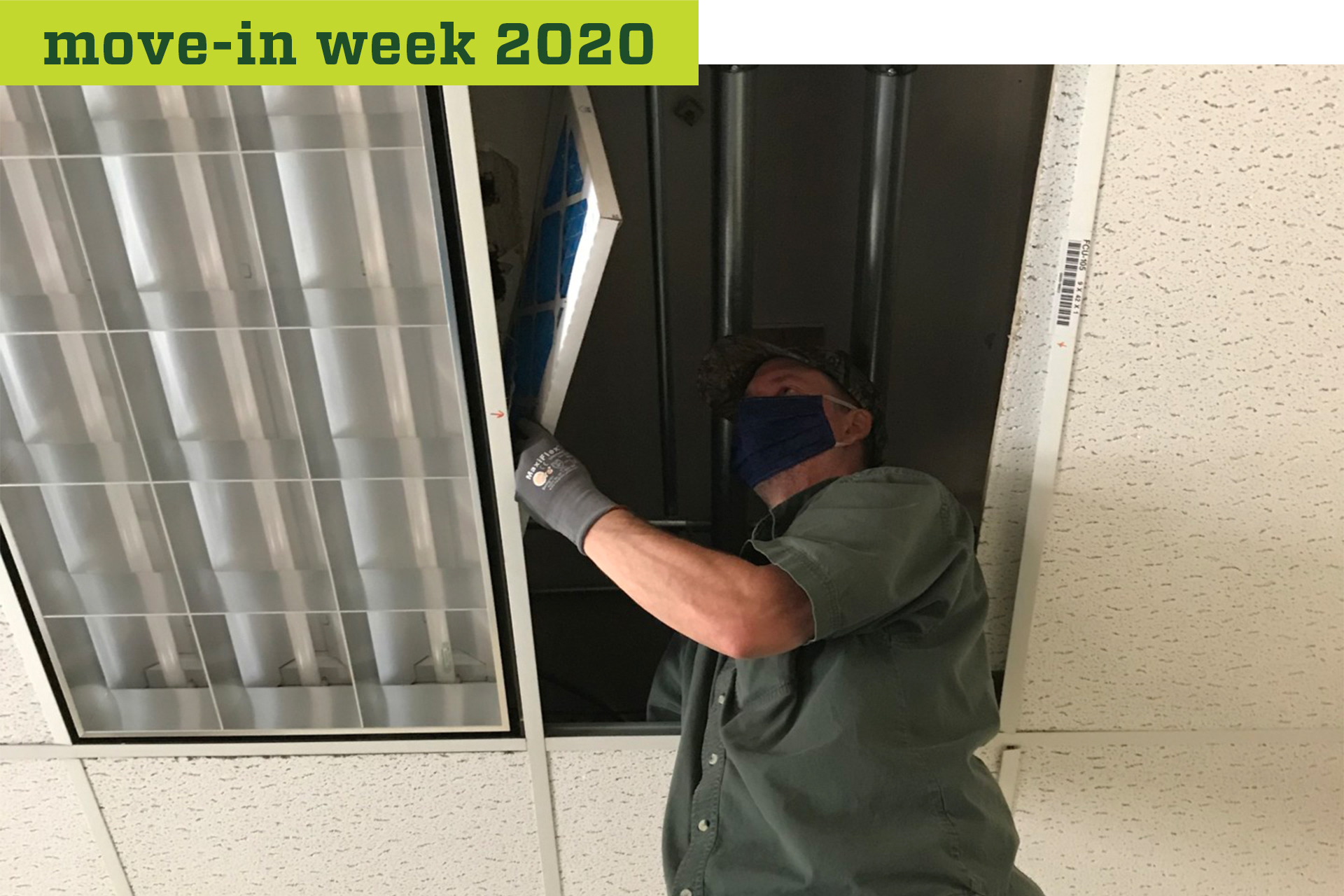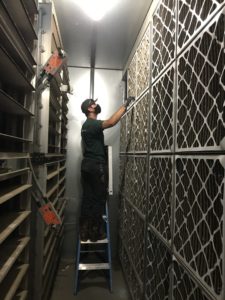
CSU’s Facilities Management has been working to heighten the indoor air quality in buildings through increased ventilation, among other efforts.
For several months, the Colorado State University Facilities Management team has worked with faculty members with expertise in energy and environmental health, public health experts and members of the University’s COVID-19 Pandemic Preparedness Team to heighten the indoor air quality in buildings on all campuses. The U.S. Environmental Protection Agency emphasizes that “ensuring proper ventilation with outside air can help reduce the concentration of airborne contaminants, including viruses, indoors.”
Increased ventilation in CSU buildings, paired with the best practices recommended by the Centers for Disease Control and Prevention already being followed by CSU (reduced building occupancy, mandated face coverings, socially distant furniture placement, and increased cleaning and disinfecting building interiors), can effectively reduce the risk of COVID-19 transmission indoors.
“CSU building ventilation systems will be healthy, based on our extensive planning and preparations,” said Tom Satterly, associate vice president for Facilities Management. “I am so proud of our Facilities Management team rising up to this challenge. Ensuring the health of our students, faculty and staff is paramount, and essential to their success here at CSU.”
Satterly said Facilities Management has increased the amount of outdoor air brought in to university buildings, when possible, and if necessary installed portable HEPA filtration units.
“Our proactive actions will increase outside air to building spaces, treat return air and/or supply air to spaces via mechanical filtration or treating the air, and maintain indoor comfort as defined by temperature and relative humidity,” he said.
CSU is following American Society of Heating, Refrigerating and Air-Conditioning Engineers guidance and meeting building code requirements for healthy indoor air. Public health guidelines for building ventilation systems, which continue to evolve, include assessment, readiness and maintenance measures, new and modified designs for renovations and new buildings, filtration upgrades and reviewing operations of occupied facilities, Satterly said.
“Our team of facilities professionals takes great pride in their respective fields of expertise, and what a wonderful demonstration of our FM values: Caring, Collaborative, Experts, Progressive and Good Stewards,” he added. “I think our team truly checked all the boxes on this recent effort.”
Faculty expertise
“Keeping up to date on ASHRAE guidance is definitely the first step in keeping our buildings safe,” said Tami Bond, a professor in mechanical engineering and Scott Presidential Chair in Energy, Environment and Health, who has led a CSU faculty group evaluating the role of ventilation and airflow on aerosol transmission of infectious disease. As student activities pick up in the fall semester, the faculty group will be working closely with Facilities Management to evaluate situations that may have particular risks.
“Research will help us in responding to an emerging situation, because some knowledge may not have made it to the latest public guidance,” Bond added. “But a large campus also has a lot of operational considerations, so the partnership will be really important.”
Strict guidelines

Facilities Management also has enacted a variety of health measures to keep buildings and occupants healthy.
Daily flush of building air prior to occupancy: Ventilation systems are operated to flush all the air in a building a minimum period of 2 hours prior to the start of each day, and for 2 hours at the completion of each day.
Filtration upgrades: Filtration efficiency in existing ventilation systems has been increased on a temporary basis during the pandemic. This involves applying the highest Minimum Efficiency Reporting Value air filters applicable for the building ventilation system, and in specific situations, using High Efficiency Particulate Air units in the classroom.
LEED buildings: Leadership in Energy and Environmental Design is the most widely used green building rating system in the world. LEED-certified buildings incorporate much of the ASHRAE guidance for COVID-19, for instance, air filtration. CSU currently has 30 LEED buildings and that will continue to grow.
Cleaning Protocols:
• All custodial cleaning protocols follow CDC guidelines and protocols, including using EPA-approved disinfectants against COVID-19 and personal protective equipment.
• All custodial staff have been trained in CDC-approved protocols and provided appropriate equipment.
• Custodial staff will practice social distancing, wear facial coverings, and follow proper prevention hygiene, such as washing hands frequently and using alcohol-based (at least 60% alcohol) hand sanitizer when soap and water are not available.
• Staff are cleaning and disinfecting all high-touch surfaces in public areas daily, including tables, chairs, doors, handrails, light switches, countertops, toilets/sinks, etc. Facilities Management will not clean keyboards, touchscreens or any electronic equipment; users and instructors will be responsible for cleaning before and after use.
• Custodial staff are cleaning all horizontal and vertical surfaces daily in elevators, classrooms, conference rooms, entrances/lobbies, restrooms and lounges. Facilities Management staff will only clean exterior surfaces of appliances, including microwaves, refrigerators, toaster ovens, etc. Departments are responsible for interior appliance cleaning.
• Per CDC guidelines, staff will not spray disinfectant on sidewalks or other outdoor areas as it is not an efficient use of disinfectant supplies and has not been proven to reduce the risk of COVID-19 to the public.
• If a room has been determined to have been exposed to someone with COVID-19, the room will not be accessed by custodial staff for 24 hours, after which the room will be thoroughly cleaned and disinfected per CDC and public health guidelines.